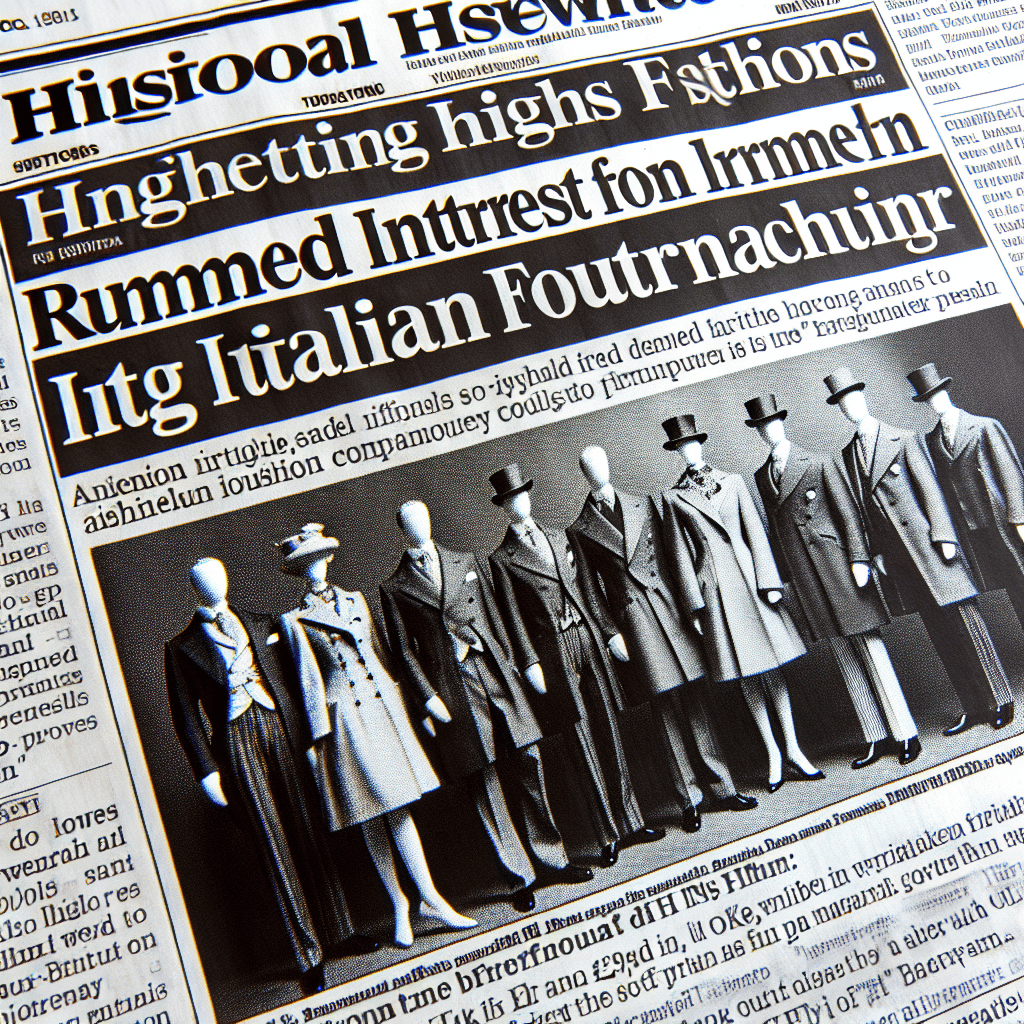“Burberry Soars: Moncler Acquisition Buzz Elevates Market Excitement”
Introduction
Burberry shares experienced a significant surge following market speculation that Italian luxury fashion brand Moncler is considering a potential acquisition. This development has sparked considerable interest and excitement among investors and industry analysts, as a merger between these two iconic brands could create a formidable entity in the luxury fashion sector. The rumors have fueled a wave of trading activity, reflecting the market’s anticipation of strategic synergies and enhanced competitive positioning that such a deal could bring. As the luxury fashion industry continues to evolve, the potential acquisition underscores the ongoing trend of consolidation among leading brands seeking to expand their global footprint and leverage complementary strengths.
Burberry’s Market Reaction: Analyzing the Share Surge
Burberry, the iconic British luxury fashion house, has recently experienced a notable surge in its share prices, driven by swirling rumors of potential acquisition interest from Moncler, the renowned Italian luxury outerwear brand. This development has captured the attention of investors and market analysts alike, prompting a closer examination of the factors contributing to this market reaction and the potential implications for both companies involved.
The initial spark for the surge in Burberry’s shares can be attributed to reports suggesting that Moncler is considering a strategic acquisition of the British brand. Such rumors, although unconfirmed, have historically had a significant impact on market dynamics, as investors often react swiftly to the prospect of mergers and acquisitions in the luxury sector. The luxury fashion industry is characterized by its competitive nature and the constant pursuit of expansion and diversification, making the potential combination of Burberry and Moncler an intriguing proposition.
In the context of Burberry’s market performance, the share surge represents a positive shift in investor sentiment. Prior to these rumors, Burberry had been navigating a challenging landscape marked by fluctuating consumer demand and evolving fashion trends. The potential acquisition by Moncler is perceived as a strategic move that could bolster Burberry’s market position, enhance its product offerings, and expand its global reach. Investors are likely considering the synergies that could arise from such a merger, including the integration of Moncler’s expertise in outerwear with Burberry’s heritage in trench coats and luxury apparel.
Moreover, the luxury fashion industry has witnessed a trend of consolidation in recent years, with major players seeking to strengthen their portfolios through strategic acquisitions. This trend is driven by the desire to capture a larger share of the market, leverage brand equity, and achieve economies of scale. In this context, the rumored interest from Moncler aligns with broader industry dynamics, where companies are increasingly looking to diversify their product lines and tap into new customer segments.
While the rumors have undoubtedly fueled optimism among investors, it is important to approach such developments with caution. The luxury fashion sector is inherently volatile, and the success of any potential acquisition hinges on a multitude of factors, including regulatory approvals, cultural alignment, and effective integration strategies. Additionally, both Burberry and Moncler have distinct brand identities and customer bases, which would require careful consideration to ensure a harmonious merger that preserves the unique attributes of each brand.
In conclusion, the surge in Burberry’s share prices following rumors of Moncler’s acquisition interest underscores the significant impact that market speculation can have on investor behavior. The potential merger represents a strategic opportunity for both companies to enhance their competitive positions in the luxury fashion industry. However, it is essential for stakeholders to remain vigilant and consider the complexities involved in such transactions. As the situation unfolds, market participants will be closely monitoring any official announcements or developments that could provide further clarity on the future trajectory of Burberry and Moncler. Ultimately, the outcome of this rumored acquisition will have far-reaching implications for the luxury fashion landscape, shaping the strategies and fortunes of these iconic brands in the years to come.
Moncler’s Acquisition Strategy: What Burberry Brings to the Table
In recent weeks, the fashion industry has been abuzz with speculation surrounding a potential acquisition involving two of its most iconic brands: Burberry and Moncler. The rumors suggest that Moncler, known for its luxury outerwear and innovative designs, is considering acquiring Burberry, a British heritage brand renowned for its classic trench coats and signature tartan patterns. This potential acquisition has led to a surge in Burberry’s share prices, reflecting investor optimism about the strategic benefits that such a merger could bring to both companies.
To understand the implications of this potential acquisition, it is essential to examine Moncler’s acquisition strategy and what Burberry could contribute to it. Moncler has long been recognized for its ability to blend luxury with functionality, creating high-end products that appeal to a discerning global clientele. The brand’s strategy has often focused on expanding its market presence and diversifying its product offerings, while maintaining its core identity rooted in quality and innovation. Acquiring Burberry could align with Moncler’s strategic goals by providing access to a broader product range and a more extensive retail network.
Burberry, with its rich history and strong brand identity, offers several advantages that could complement Moncler’s existing portfolio. Firstly, Burberry’s extensive experience in the fashion industry and its established reputation for craftsmanship could enhance Moncler’s product development capabilities. By leveraging Burberry’s expertise in creating timeless pieces, Moncler could expand its offerings beyond outerwear, potentially venturing into new categories such as ready-to-wear apparel and accessories. This diversification could attract a wider customer base and increase revenue streams for the combined entity.
Moreover, Burberry’s global retail presence is another significant asset that Moncler could capitalize on. With flagship stores in major cities worldwide, Burberry has cultivated a robust distribution network that could facilitate Moncler’s expansion into new markets. This synergy could be particularly beneficial in regions where Moncler is looking to strengthen its foothold, such as Asia and North America. By utilizing Burberry’s established retail infrastructure, Moncler could accelerate its growth trajectory and enhance its competitive position in the luxury fashion sector.
In addition to these strategic benefits, the potential acquisition could also foster innovation through the exchange of creative ideas and design philosophies. Both brands have a history of pushing the boundaries of fashion, and their collaboration could lead to the development of unique and groundbreaking collections. By combining Moncler’s technical expertise in performance wear with Burberry’s mastery of classic tailoring, the merged entity could set new trends and redefine luxury fashion for the modern consumer.
However, it is important to note that while the potential acquisition presents numerous opportunities, it also poses challenges that must be carefully navigated. Integrating two distinct corporate cultures and aligning their strategic visions will require meticulous planning and execution. Additionally, maintaining the unique identities of both brands while creating a cohesive brand narrative will be crucial to the success of the merger.
In conclusion, the rumors of Moncler’s interest in acquiring Burberry have sparked significant interest and speculation within the fashion industry. If realized, this acquisition could offer substantial strategic benefits, including product diversification, expanded market reach, and enhanced innovation capabilities. As the industry awaits further developments, the potential merger of these two iconic brands promises to reshape the landscape of luxury fashion, offering exciting possibilities for both companies and their customers.
Investor Sentiment: How Rumors Impact Burberry’s Stock Performance
In the ever-evolving landscape of the fashion industry, the intersection of luxury and market dynamics often leads to intriguing developments. Recently, Burberry, the iconic British luxury brand, has found itself at the center of investor attention due to rumors of acquisition interest from Moncler, the renowned Italian outerwear company. This speculation has led to a notable surge in Burberry’s stock performance, highlighting the profound impact that market rumors can have on investor sentiment and stock valuations.
To understand the recent uptick in Burberry’s shares, it is essential to consider the broader context of the luxury fashion market. Both Burberry and Moncler are established names with strong brand identities and loyal customer bases. Burberry, known for its classic trench coats and signature check pattern, has been a symbol of British elegance for over a century. Meanwhile, Moncler has carved out a niche in the luxury outerwear segment, renowned for its high-quality down jackets and innovative designs. The potential synergy between these two brands, should an acquisition occur, is a tantalizing prospect for investors.
The mere rumor of Moncler’s interest in acquiring Burberry has been enough to send ripples through the stock market. Investors, always on the lookout for opportunities to capitalize on potential mergers and acquisitions, have responded with enthusiasm. This reaction underscores the power of speculation in financial markets, where even unconfirmed reports can lead to significant shifts in stock prices. In this case, the anticipation of a possible merger has fueled optimism about Burberry’s future prospects, driving up its share value.
Moreover, the impact of such rumors extends beyond immediate stock price fluctuations. They also influence investor sentiment, shaping perceptions of a company’s strategic direction and growth potential. In the case of Burberry, the speculation surrounding a possible acquisition by Moncler has sparked discussions about the brand’s future trajectory. Investors are keen to assess how such a move could enhance Burberry’s market position, expand its product offerings, and potentially lead to cost synergies. This forward-looking perspective is crucial in understanding why rumors can have a lasting effect on stock performance.
However, it is important to approach these developments with a degree of caution. While rumors can drive short-term market movements, they do not always translate into concrete outcomes. The luxury fashion industry is no stranger to speculation, and not all rumored acquisitions come to fruition. Therefore, investors must weigh the potential benefits of a merger against the inherent uncertainties and risks involved. This balanced approach is essential to making informed investment decisions in a market characterized by volatility and rapid change.
In conclusion, the recent surge in Burberry’s shares, driven by rumors of Moncler’s acquisition interest, serves as a compelling example of how investor sentiment can be swayed by market speculation. The luxury fashion industry, with its allure and prestige, remains a fertile ground for such developments. As investors navigate this dynamic landscape, they must remain vigilant, discerning fact from fiction, and considering both the opportunities and challenges that lie ahead. Ultimately, the interplay between rumors and stock performance underscores the intricate relationship between market perception and financial reality, reminding us of the complexities inherent in the world of luxury fashion investments.
Fashion Industry Consolidation: The Implications of a Burberry-Moncler Deal

In recent weeks, the fashion industry has been abuzz with speculation following reports that Burberry, the iconic British luxury brand, may be the target of acquisition interest from Moncler, the Italian outerwear specialist. This potential merger has sent ripples through the market, with Burberry shares experiencing a notable surge as investors react to the possibility of a significant consolidation within the luxury fashion sector. As the industry grapples with the implications of such a deal, it is essential to consider the potential benefits and challenges that could arise from this union.
To begin with, the strategic rationale behind Moncler’s interest in Burberry is worth examining. Moncler, renowned for its high-performance outerwear, has been seeking to diversify its portfolio and expand its global footprint. Acquiring Burberry would provide Moncler with an opportunity to broaden its product offerings and tap into Burberry’s well-established brand heritage and extensive retail network. Furthermore, Burberry’s strong presence in the Asian market, particularly in China, aligns with Moncler’s ambitions to strengthen its position in this rapidly growing region. Consequently, a merger could create a formidable entity capable of competing more effectively with other luxury giants.
Moreover, the potential synergies between the two companies could lead to significant cost savings and operational efficiencies. By combining their resources, Moncler and Burberry could streamline their supply chains, optimize production processes, and leverage economies of scale. This could result in improved profit margins and enhanced shareholder value. Additionally, the collaboration could foster innovation, as the two brands share expertise and insights, potentially leading to the development of new product lines that blend Moncler’s technical prowess with Burberry’s classic design aesthetic.
However, despite these potential advantages, the merger also presents several challenges that must be carefully navigated. One of the primary concerns is the integration of two distinct corporate cultures. Burberry, with its British heritage and emphasis on tradition, may have a different organizational ethos compared to Moncler’s Italian roots and focus on innovation. Successfully merging these cultures will require careful management to ensure that both brands retain their unique identities while working towards common goals.
Furthermore, regulatory hurdles could pose significant obstacles to the completion of the deal. Given the size and influence of both companies, antitrust authorities may scrutinize the merger to ensure it does not stifle competition within the luxury fashion market. This could lead to protracted negotiations and potential divestitures, which may impact the overall value proposition of the acquisition.
In addition to these challenges, the broader implications of such a consolidation must be considered. The luxury fashion industry has been experiencing a wave of mergers and acquisitions as companies seek to bolster their market positions in an increasingly competitive landscape. A successful Burberry-Moncler deal could set a precedent for further consolidation, prompting other brands to explore similar opportunities. This could lead to a reshaping of the industry, with a few dominant players exerting greater influence over market trends and consumer preferences.
In conclusion, while the rumors of Moncler’s interest in acquiring Burberry have sparked excitement and speculation, the potential merger presents both opportunities and challenges. The successful integration of these two iconic brands could create a powerful entity capable of driving innovation and growth within the luxury fashion sector. However, careful consideration must be given to the complexities of merging distinct corporate cultures and navigating regulatory hurdles. As the industry watches closely, the outcome of this potential deal could have far-reaching implications for the future of fashion industry consolidation.
Burberry’s Brand Value: Why Moncler Might Be Interested
Burberry, a name synonymous with British luxury fashion, has recently seen a surge in its share prices, fueled by rumors of acquisition interest from Moncler, the Italian luxury outerwear brand. This development has sparked widespread speculation and analysis within the fashion and financial sectors, as stakeholders attempt to understand the potential motivations behind such a move. At the heart of this speculation lies Burberry’s brand value, a multifaceted asset that could be highly attractive to Moncler.
To begin with, Burberry’s rich heritage and iconic status in the fashion industry are undeniable. Established in 1856, the brand has built a legacy of craftsmanship and innovation, most notably with its invention of gabardine fabric and the creation of the trench coat. This historical significance not only adds to Burberry’s allure but also provides a strong foundation for brand loyalty and recognition worldwide. For Moncler, acquiring a brand with such a storied past could enhance its own brand narrative, allowing it to tap into Burberry’s established market presence and customer base.
Moreover, Burberry’s commitment to sustainability and digital innovation aligns well with current industry trends, making it an attractive prospect for any potential acquirer. The brand has made significant strides in reducing its environmental impact, with initiatives aimed at achieving carbon neutrality and promoting sustainable practices throughout its supply chain. In an era where consumers are increasingly conscious of environmental issues, Burberry’s efforts in this area enhance its brand value. Moncler, which has also been focusing on sustainability, could benefit from Burberry’s experience and reputation in this domain, further solidifying its own commitments to responsible luxury.
In addition to sustainability, Burberry’s digital transformation strategy has positioned it as a leader in the integration of technology and fashion. The brand has embraced digital platforms to enhance customer engagement, offering immersive experiences through augmented reality and virtual fashion shows. This forward-thinking approach not only appeals to tech-savvy consumers but also sets a benchmark for innovation in the luxury sector. Moncler, known for its high-performance outerwear, could leverage Burberry’s digital expertise to expand its reach and enhance its customer interactions, thereby increasing its competitive edge.
Furthermore, Burberry’s global retail network and strong presence in key markets such as Asia and the United States present significant growth opportunities. The brand’s ability to resonate with diverse consumer segments across different regions is a testament to its adaptability and appeal. For Moncler, acquiring Burberry could provide a strategic advantage in expanding its footprint and accessing new markets, particularly in Asia, where Burberry has a well-established presence.
In conclusion, the rumors of Moncler’s interest in acquiring Burberry can be attributed to several compelling factors that underscore Burberry’s brand value. Its rich heritage, commitment to sustainability, digital innovation, and global market presence collectively enhance its attractiveness as a potential acquisition target. While the outcome of these rumors remains uncertain, the potential synergies between the two brands could create a formidable force in the luxury fashion industry, offering both companies new avenues for growth and innovation. As the situation unfolds, industry observers will undoubtedly keep a close watch on any developments, eager to see how this potential acquisition could reshape the landscape of luxury fashion.
Financial Analysis: The Potential Impact of an Acquisition on Burberry’s Valuation
Burberry, the iconic British luxury fashion house, has recently seen a notable surge in its share prices, driven by rumors of potential acquisition interest from Moncler, the Italian luxury outerwear brand. This development has sparked considerable interest among investors and analysts alike, as the implications of such a move could significantly alter Burberry’s market valuation and strategic positioning within the luxury fashion industry. To understand the potential impact of this acquisition on Burberry’s valuation, it is essential to consider several key factors, including market synergies, brand alignment, and financial performance.
Firstly, the potential synergies between Burberry and Moncler could play a crucial role in enhancing Burberry’s market valuation. Both brands are renowned for their strong heritage and commitment to quality, albeit with distinct product focuses. Burberry’s expertise in trench coats, ready-to-wear collections, and accessories complements Moncler’s specialization in high-end outerwear. This complementary nature could lead to operational efficiencies, such as shared supply chains and distribution networks, which may result in cost savings and improved profit margins. Furthermore, the combined entity could leverage its expanded product portfolio to capture a broader customer base, thereby driving revenue growth.
In addition to operational synergies, the alignment of brand values and market positioning is another critical factor that could influence Burberry’s valuation. Both Burberry and Moncler have successfully cultivated a strong brand identity, characterized by exclusivity and luxury. An acquisition could enhance Burberry’s brand equity by associating it with Moncler’s reputation for innovation and craftsmanship. This alignment could also facilitate cross-brand collaborations and co-branded collections, further strengthening the brand’s appeal to discerning consumers. Consequently, a successful integration of the two brands could lead to an enhanced market presence and increased pricing power, positively impacting Burberry’s valuation.
Moreover, the financial performance of both companies will be a significant determinant of the acquisition’s impact on Burberry’s valuation. Burberry has demonstrated resilience in recent years, with steady revenue growth and a robust balance sheet. Meanwhile, Moncler has consistently delivered strong financial results, driven by its strategic focus on product innovation and global expansion. The combination of these financial strengths could create a formidable entity with enhanced financial stability and growth prospects. Investors may view this as an opportunity for value creation, potentially leading to a re-rating of Burberry’s shares.
However, it is important to acknowledge the potential risks associated with such an acquisition. The integration of two distinct corporate cultures and management teams could pose challenges, potentially affecting operational efficiency and employee morale. Additionally, regulatory hurdles and antitrust considerations may arise, particularly given the significant market share that the combined entity would command in the luxury fashion sector. These factors could introduce uncertainties that may weigh on Burberry’s valuation in the short term.
In conclusion, the rumors of Moncler’s acquisition interest in Burberry have generated significant excitement in the financial markets, with the potential to reshape Burberry’s valuation and strategic trajectory. While the prospect of operational synergies, brand alignment, and enhanced financial performance presents a compelling case for value creation, it is essential to remain cognizant of the potential risks and challenges that may accompany such a transaction. As the situation unfolds, investors and analysts will closely monitor developments to assess the long-term implications for Burberry’s market position and shareholder value.
Strategic Moves: How Burberry Could Benefit from a Moncler Acquisition
Burberry, the iconic British luxury fashion house, has recently seen a notable surge in its share prices, fueled by rumors of potential acquisition interest from Moncler, the renowned Italian luxury outerwear brand. This development has sparked considerable interest and speculation within the fashion and financial sectors, as stakeholders ponder the strategic implications of such a merger. The potential acquisition of Burberry by Moncler could herald a new era of growth and innovation for both brands, offering a range of strategic benefits that could enhance their competitive positioning in the global luxury market.
To begin with, a merger between Burberry and Moncler could create a formidable entity in the luxury fashion industry, combining the strengths and heritage of both brands. Burberry, with its rich history and strong brand identity, is renowned for its classic trench coats, signature check patterns, and British elegance. On the other hand, Moncler has carved out a niche for itself with its high-performance outerwear and stylish down jackets, appealing to a younger, fashion-forward demographic. By joining forces, the two brands could leverage their complementary strengths to expand their product offerings and appeal to a broader customer base.
Moreover, the acquisition could provide significant synergies in terms of operational efficiencies and cost savings. Both Burberry and Moncler have established global supply chains and distribution networks, which could be optimized to reduce costs and improve margins. Additionally, the combined entity could benefit from shared marketing and advertising efforts, enhancing brand visibility and customer engagement across diverse markets. This could be particularly advantageous in the current economic climate, where luxury brands are seeking to maximize profitability while navigating challenges such as fluctuating consumer demand and rising production costs.
Furthermore, the merger could facilitate greater innovation and creativity within the combined brand portfolio. By pooling their design expertise and resources, Burberry and Moncler could accelerate the development of new products and collections, pushing the boundaries of fashion and technology. This could include collaborations on cutting-edge materials, sustainable practices, and digital initiatives, aligning with the growing consumer demand for environmentally conscious and technologically advanced fashion. Such innovations could not only strengthen the brand’s market position but also attract a new generation of consumers who prioritize sustainability and innovation in their purchasing decisions.
In addition to these strategic benefits, the acquisition could also enhance the global reach and market penetration of both brands. Burberry’s strong presence in Europe and Asia, coupled with Moncler’s popularity in North America, could create a more balanced and diversified geographic footprint. This expanded reach could enable the combined entity to tap into emerging markets and capitalize on growth opportunities in regions such as China and India, where the appetite for luxury goods continues to rise. By leveraging their combined brand equity and market knowledge, Burberry and Moncler could effectively navigate the complexities of these markets and establish a stronger foothold in the global luxury landscape.
In conclusion, while the rumors of Moncler’s acquisition interest in Burberry remain speculative, the potential strategic benefits of such a merger are undeniable. By combining their strengths, optimizing operations, fostering innovation, and expanding their global reach, Burberry and Moncler could create a powerful luxury fashion powerhouse poised for long-term success. As the industry continues to evolve, this potential acquisition could serve as a catalyst for growth and transformation, setting a new benchmark for strategic collaboration in the luxury sector.
Q&A
1. **What caused Burberry shares to surge?**
Burberry shares surged due to rumors of acquisition interest from Moncler.
2. **Who is rumored to be interested in acquiring Burberry?**
Moncler is rumored to be interested in acquiring Burberry.
3. **What is the primary business of Burberry?**
Burberry is a luxury fashion brand known for its iconic trench coats and distinctive tartan pattern.
4. **What is Moncler known for?**
Moncler is known for its high-end outerwear, particularly its luxury down jackets.
5. **How did the market react to the rumors of the acquisition?**
The market reacted positively, leading to a surge in Burberry’s share price.
6. **Have either Burberry or Moncler confirmed the acquisition rumors?**
As of the latest information, neither Burberry nor Moncler has confirmed the acquisition rumors.
7. **What impact could this acquisition have on the luxury fashion industry?**
If the acquisition occurs, it could lead to significant consolidation in the luxury fashion industry, potentially creating a more formidable competitor in the market.
Conclusion
The surge in Burberry shares following rumors of Moncler’s acquisition interest highlights the market’s positive reaction to potential strategic mergers and acquisitions in the luxury fashion sector. Such speculation often drives investor optimism, reflecting expectations of enhanced brand synergy, expanded market reach, and increased competitive advantage. However, while the immediate market response is favorable, the long-term impact on Burberry’s financial performance and brand identity will depend on the actualization of the acquisition and its subsequent integration strategy.





